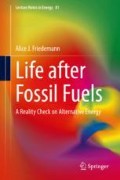Abstract
Fossil fuels are energy storage. There is very little electricity stored now because with fossils there has been no need for it. The coal and natural gas that generate two-thirds of electricity and nuclear uranium that generates 20% of power are the energy storage, and have provided many decades of energy storage so far. Wind and solar electricity are intermittent. Sometimes there is too little and sometimes there is more than the grid can use. The extent to which intermittent wind and solar can supplant fossil fuels will depend on storage for when the sun and wind die out, up to several weeks seasonally. This chapter looks at potential ways to store electricity with a national grid, pumped hydro storage (PHS), electrochemical batteries, compressed air energy storage (CAES), concentrated solar power with thermal energy storage, and biomass energy storage.
Access this chapter
Tax calculation will be finalised at checkout
Purchases are for personal use only
References
Akhil AA, Huff G, Currier AB, et al (2013) Electricity storage handbook in collaboration with NRECA. Sandia National Laboratories and Electric Power Research Institute
ASCE (2017) America’s infrastructure report card. Energy D+. American society of civil engineers
Barnhart CJ, Benson SM (2013) On the importance of reducing the energetic and material demands of electrical energy storage. Energy & Environment Science 6:1083–1092
Blumsack SA (2006) Network topologies and transmission investment under electric-industry restructuring. Carnegie Mellon University, Pittsburgh
Brown M, Cibulka L, Miller L, et al (2008) Transmission technology research for renewable integration. California Energy Commission
DOE (2002) National transmission grid study. United States Department of Energy
Droste-Franke B (2015) Review of the need for storage capacity depending on the share of renewable energies (Chap. 6). In Electrochemical energy storage for renewable sources and grid balancing. Elsevier
EIA (2019) Most utility-scale batteries in the United States are made of lithium-ion. U.S. Energy Information Administration. https://www.eia.gov/todayinenergy/detail.php?id=41813. Accessed 4 Nov 2020
Greenblatt J, Long J, Hannegan B (2012) California’s energy future: electricity from renewable energy and fossil fuels with carbon capture and sequestration. California Council on Science and Technology, California
Hovorka S, Nava R (2009) Characterization of bedded salt for storage caverns: case study from the Midland Basin. U.S. Department of Energy
IEA (2020) Key world energy statistics. International Energy Agency
Makansi J (2007) Lights out: the electricity crisis, the global economy, and what it means to you. Wiley
Michaelides EE (2012) Alternative energy sources. Springer
Mongird K, Viswanathan V, Balducci P et al (2019) Energy storage technology and cost characterization report. U.S. Department of Energy
Munson R (2008) From Edison to Enron: The business of power and what it means for the future of electricity. Praeger
Palmer G (2020) Energy storage and civilization: a systems approach. Springer
Penn I (2018) How zinc batteries could change energy storage. New York Times
SBC (2013) Electricity storage Factbook. SBC Energy Institute. https://www.cpuc.ca.gov/WorkArea/DownloadAsset.aspx?id=3170. Accessed 4 Nov 2020
Serna J, Rainey J (2019) California’s huge, humiliating power outages expose the vulnerabilities of PG&E’s power grid. https://www.latimes.com/california/story/2019-10-10/pg-e-california-power-outages-grid-climate-change. Accessed 4 Nov 2020
Smil V (2010) Energy myths and realities. AIE Press
Vazquez S, Lukic SM, Galvan E et al (2010) Energy storage systems for transport and grid applications. IEEE Trans Ind Electron 57:3881–3895
Vikström H, Davidsson S, Höök M (2013) Lithium availability and future production outlooks. Appl Energy 110:252–266
Wikipedia (2020) Ivanpah Solar Power Facility. https://en.wikipedia.org/wiki/Ivanpah_Solar_Power_Facility. Accessed 22 Nov 2020
Author information
Authors and Affiliations
Rights and permissions
Copyright information
© 2021 The Author(s), under exclusive license to Springer Nature Switzerland AG
About this chapter
Cite this chapter
Friedemann, A.J. (2021). Energy Storage: Excess Electricity from Solar and Wind Must Be Stored. In: Life after Fossil Fuels. Lecture Notes in Energy, vol 81. Springer, Cham. https://doi.org/10.1007/978-3-030-70335-6_11
Download citation
DOI: https://doi.org/10.1007/978-3-030-70335-6_11
Published:
Publisher Name: Springer, Cham
Print ISBN: 978-3-030-70334-9
Online ISBN: 978-3-030-70335-6
eBook Packages: EnergyEnergy (R0)

